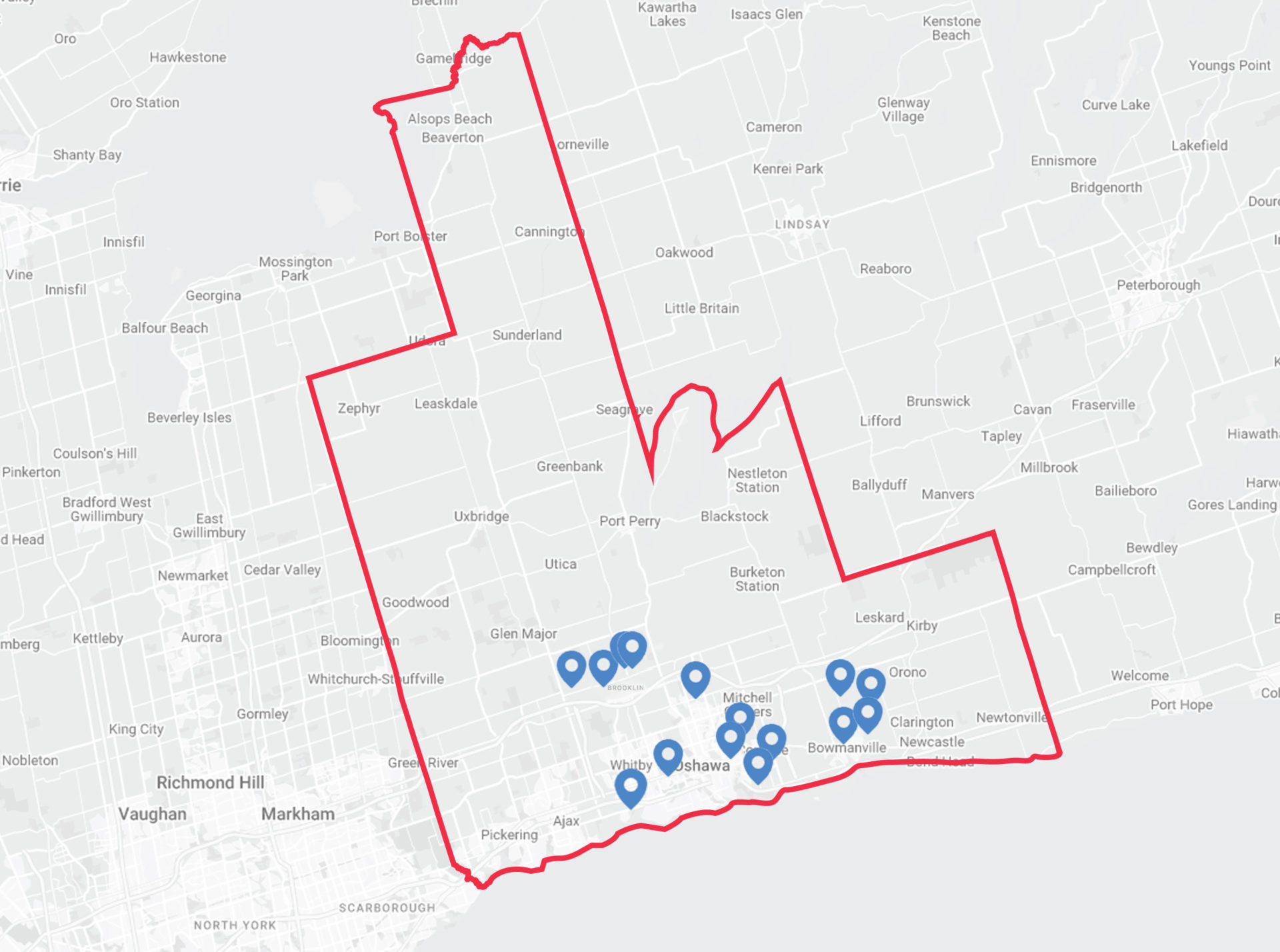

Greybrook has been investing in the growing region since 2017 and is continuing to actively evaluate both low-rise and high-rise investment opportunities to meet the needs of Durham Region’s growing population.

Click here to view Greybrook’s portfolio in Durham Region
Located east of the City of Toronto, this booming Region nestled between Lake Ontario, Lake Simcoe, and Lake Scugog, is comprised of eight diverse cities, municipalities, and townships with the southern portion of the Region along Lake Ontario encompassing the more suburban cities and towns and the northern portion encompassing the more rural areas and small towns.
Over the last fifteen years, Durham Region’s population has grown by approximately 25%, from 561,258 in 2006 to nearly 700,000 and climbing daily.(1) Between 2016 and 2021, Durham Region saw a 7.9% increase to its population with the Municipality of Clarington and the City of Oshawa welcoming the highest number of new residents at a rate of 10.2% and 10%, respectively.(2) The Region’s notable expansion is showing no signs of slowing with the Growth Plan forecasting that the population will nearly double in 2051 to 1.3 million residents. As Canada continues to increase its annual immigration targets and more Canadians are drawn to the Region’s growing goods and service producing sectors geared towards innovation and technology, in combination with its relative housing affordability, there is no doubt the Region will be continue to experience steady growth.(3)
During the pandemic, many Canadians opted to live outside of Canada’s largest urban centres in favour of relocating to smaller, more affordable communities with homes offering the benefit of additional space at a more attainable price point. As a result, Toronto saw outward migration of 50,375 people between July 2019 and July 2020, while the Oshawa Census Metropolitan Area, Durham Region’s most populated area which includes Whitby and Clarington, experienced strong population growth at 2.1% over the same period.(4)
Oshawa was identified as the hottest market in the GTHA with property values surging by nearly 50% over a 12-month period during the pandemic. In comparison, Mississauga values had gone up by 6%, while Brampton and Vaughan had gone up by 11% and 5%, respectively.(5) Given Durham Region’s substantial growth and anticipated future expansion, it is evident that strong development momentum is required to meet the housing needs of its growing population. In addition, substantial variety in housing type will be required to meet the unique needs of a variety of prospective home purchasers.
At our recent Inside Track event, Steve Deveaux, Executive Vice President, Land Development at Tribute Communities referenced the City of Pickering as a terrific example of the strides being taken to achieve adequate housing supply by having a development-friendly government office working closely with investors and developers to build more in the area. Long-time councillor and newly elected Mayor of Whitby, Elizabeth Roy, mirrors this sentiment having stated one of her first priorities will be to deal with the provincial government’s housing targets legislation.
In 2021, the number of building permits issued in Oshawa totalled their second highest volume on record, representing over $560 Million of invested development capital. The development momentum in Oshawa is evident with 2022 promising another strong year with year-to-date construction records having already surpassed 2021 by $50 million, as noted by Oshawa’s Economic and Development Services Committee Chair, Councillor Tito-Dante Marimpietri.(6)
With strong roots and an abundance of projects in the Durham Region, Greybrook’s long-standing developer partner, Tribute Communities, has built thousands of homes in the Region and is greatly contributing to the vertical growth and high-rise evolution in Durham with multi-tower high-rise condo developments including U.C. Towers 1, 2, and 3 in North Oshawa and VuPoint Condos in Pickering, in aggregate expected to bring more than 3,200 units to market.
Intensification is also occurring near transit nodes such as the Whitby GO Station, located just steps away from the Port of Whitby Marina, with the development of mixed-use high-rise condominiums and townhomes underway in this area. Brookfield has plans to reinvigorate this part of the Whitby waterfront with their Dockside development, a master-planned community currently under construction which is expected to deliver more than 1,500 residential units and 30,000 square feet of commercial and retail space. Other developments include The Landing, which is under construction and slated to deliver over 340 condo and stacked townhome units to the area and The Boatworks Towns, which will bring 108 townhome units to the area. Once complete, these three projects are expected to bring over 1,950 units to the Port Whitby community alone.
The future economic success and population growth potential of Durham Region will depend on providing the necessary infrastructure, diverse business ecosystem, and talent pipeline required to establish self-sustaining urban epicentres that rival Canada’s largest urban centres.
Durham Region has attracted significant investment in infrastructure to increase accessibility and economic opportunities to support the growing Region. In 2019, The Ontario Ministry of Transportation completed a $1.2 billion project that extends Highway 407 by approximately 22 kilometres to the East from Harmony Road in Oshawa to Highway 35/115 in Clarington and connects Highways 401 and 407 with Highway 418 that serves as the north-south link.(7) This critical infrastructure investment offers efficient access to other areas of the GTHA and significantly improves the flow of goods, services, and people, contributing to the Region’s growing attraction and offering enhanced opportunities for business, transportation and employment. In 2020, the Metrolinx Board of Directors endorsed the GO East Rail Extension through Oshawa to Bowmanville in Clarington which once complete will include four new station stops to support the creation of an integrated transportation that will play an important role in supporting economic activity and accessibility to areas further east in the Region.(8)
With strong sector diversification and an educated and skilled workforce, Durham is well-positioned for continued economic and job growth. While the Region’s population is projected to nearly double in 2051, the local economy is expected to see strong job growth with areas like the Oshawa CMA increasing to over 460,000 jobs by 2051 from the current 224,000 jobs.(3)
Over the last decade, Durham Region has changed significantly due to revitalization efforts and a shift toward technology and innovation industries. In the 2020 Scoring Canadian Tech Talent report released by CBRE, Oshawa was ranked as one of the top five markets for tech talent growth in Canada, joining Toronto as the only two GTHA cities included in the top 20 rankings.(9) In 2022, Durham Region was named one of the top seven Intelligent Communities by the Intelligent Community Forum which recognizes communities that exemplify best practices in economic, social and cultural development with a focus on technology and digital integration.(10)
Anchoring the Region’s education and talent cluster are three top-rated post-secondary institutions, Durham College, Ontario Tech University, and Trent University Durham GTA, offering access to specialized, leading-edge research and development facilities and innovation centres to support the business community in the development of innovative, practical solutions. With over 30,000 full-time students enrolled annually, Durham Region offers a diverse business ecosystem and a robust talent pipeline that is driving innovation and leading economic growth.(11)
Greybrook has been investing in the development of new housing in the Region to support its growing population since 2017 with our first investment in the development of a single-detached housing community in the Town of Bowmanville. Our regional footprint encompasses low-rise development communities featuring townhomes and single-detached residences with projects in Whitby, Oshawa, Brooklin, Courtice, and Bowmanville. Overall, our growing portfolio of 15 investments is expected to deliver upwards of 3,800 new homes to the Region, and we look forward to closing our latest investment in the Durham Region in the Port Whitby Marina area, which will be Greybrook’s first high-rise project in the Region.
We continue to actively evaluate high-quality investment opportunities across the development-friendly region, leveraging our knowledge and collective expertise with our active developer partners to acquire the best parcels of land and execute strategic business plans that enable us to create value for investors while delivering homes to address the supply shortage and meet the growing demand for housing in the Region.
(1) Durham Region Profile – Demographic & Socioeconomic Data
(2) Statistic Canada – Census Profile, 2021
(3) Envision Durham – Growth Management Study, 2021
(4) Canada’s Population Estimates – Subprovincial Areas, July 2020
(5) Strata – Oshawa Condo Values
(6) Durham Post – Durham Likely to Outpace Future Ontario Growth
(7) Infrastructure Ontario – Highway 407 East
(8) Invest Durham – Metrolinx Confirms GO Lakeshore East Rail Extension
(9) CBRE Canada – Scoring Canadian Tech Talent, 2020
(10) Intelligent Community Forum – Top7 Intelligent Communities of the Year, 2022